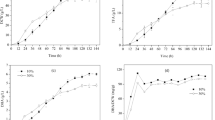Abstract
An isolate of Isochrysis galbana rich in eicosapentaenoic acid (EPA) and docosahexaenoic acid (DHA) has been grown as a chemostat culture at 20° C and pH 8.00 controlled by CO2 injection. From a low dilution rate (D) of 0.0024 h−1 to 0.0377 h−1, close to maximum growth, a decrease in EPA content from 5.21% dry weight (d.w.) to 2.80% d.w. was observed, although the percentage of EPA in the total fatty acids increased. Lipids were fractionated, EPA being the major fatty acid found in the glycolipid fraction, whereas in the neutral lipid fraction were mainly palmitic and palmitoleic acids. At the same time, the biomass concentration also decreased from 1015 mg·l−1 to 202 mg·l−1 over the range of Ds mentioned. Nonetheless, EPA productivity had a maximum value of 15.26 mg·l−1·day−1 at D=0.0208 h−1.
Similar content being viewed by others
References
Hansmann E (1973) Pigment analysis. In: Stein JR (ed) Handbook of phycological methods, culture methods and growth measurements. Cambridge University Press, Cambridge, p 359
Herzig R, Falkowski PG (1989) Nitrogen limitation in Isochrysis galbana (Haptophyceae). I. Photosynthetic energy conversion and growth efficiencies. J Phycol 25:462–471
Kates M (1986) Techniques of lipidology: isolation, analysis and identification of lipids. 2nd revised edn. In: Burdon RH, Knippenberg PH van (eds) Laboratory techniques in biochemistry and molecular biology, vol 3, part 2. Elsevier, Amsterdam, pp 190–195
Kates M, Volcani BE (1966) Lipid components of diatoms. Biochem Biophys Acta 116:264–278
Kyle D (1992) Production and use of lipids from microalgae. Lipid Technol May–June:59–64
Kochert G (1978) Quantitation of the macromolecular components of microalgae. In: Hellebust J, Cragie S (eds) Handbook of phycological methods. Physiological and biochemical methods. Cambridge University Press, Cambridge, p 189
Lepage G, Roy C (1984) Improved recovery of fatty acid through direct transesterification without prior extraction or purification. J Lipid Res 25:1391–1396
López Alonso D, Molina Grima E, Sánchez Pérez JA, García Sánchez JL, García Camacho F (1992a) Isolation of clones of Isochrysis galbana rich in eicosapentaenoic acid. Aquaculture 102:363–371
López Alonso D, Molina Grima E, Sánchez Pérez JA, García Sánchez JL, García Camacho F (1992b) Fatty acid variation among different isolates of a single strain of Isochrysis galbana. Phytochemistry 31:3901–3904
Lowry OH, Rosebrough NJ, Farr AL, Randall RJ (1951) Protein measurement with the Folin phenol reagent. J Biol Chem 193:265–275
Molina Grima E, Martínez ME, Sánchez S, García F, Contreras A (1991) Growth and biochemical composition with amphasis on the fatty acids of Tetraselmis sp. Appl Microbiol Biotechnol 36:21–25
Molina Grima E, Sánchez Pérez JA, García Camacho F, García Sánchez JL, López Alonso D (1993) n-3 PUFA productivity in chemostat cultures of microalgae. Appl Microbiol Biotechnol 38:599–605
Radwan SS (1991) Sources of C20-polyunsaturated fatty acids for biotechnological use. Appl Microbiol Biotechnol 35:421–430
Whyte JN (1987) Biochemical composition and energy content of six species of phytoplankton used in mariculture of bivalues. Aquaculture 75:193–203
Whyte JN (1988) Fatty acid profiles from direct methanolysis of lipids in tissue of cultured species. Aquaculture 75:193–203
Author information
Authors and Affiliations
Additional information
Correspondence to: E. Molina Grima
Rights and permissions
About this article
Cite this article
Molina Grima, E., Sánchez Pérez, J.A., García Camacho, F. et al. Effect of growth rate on the eicosapentaenoic acid and docosahexaenoic acid content of Isochrysis galbana in chemostat culture. Appl Microbiol Biotechnol 41, 23–27 (1994). https://doi.org/10.1007/BF00166076
Received:
Revised:
Accepted:
Issue Date:
DOI: https://doi.org/10.1007/BF00166076




